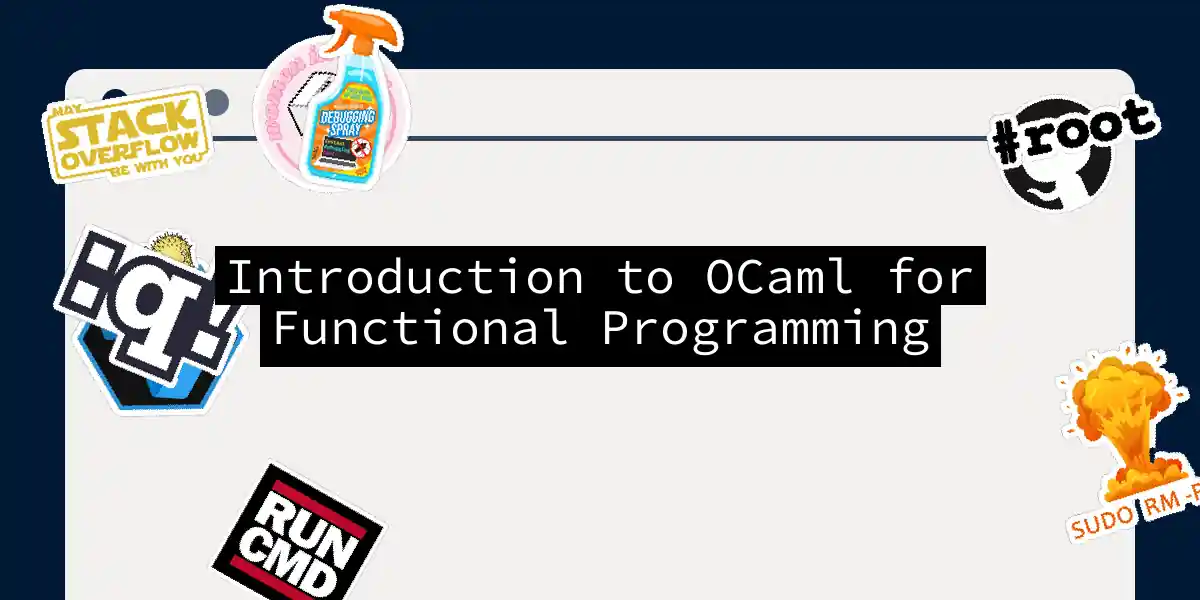Why OCaml?
In the vast landscape of programming languages, OCaml stands out as a gem for functional programming enthusiasts. Developed from the ML family of languages, OCaml combines the expressiveness of untyped languages with the safety of strongly typed languages, making it a powerful tool for building robust and efficient software. Let’s dive into the world of OCaml and explore why it’s a great choice for functional programming.
What is OCaml?
OCaml is described as an “industrial-strength functional programming language” with an emphasis on expressiveness and safety. It’s used by companies like Jane Street in the finance industry for developing complex trading systems, which speaks volumes about its reliability and performance.
Functional Programming vs. Imperative Programming
To understand OCaml, it’s crucial to grasp the difference between functional and imperative programming paradigms. Imperative languages like Python, Java, and C++ focus on sequences of explicit instructions that the computer should perform to solve a task. In contrast, functional programming languages like OCaml focus on describing the solution to a problem in terms of the evaluation of functions and the manipulation of data structures.
In functional programming, functions are treated as first-class values, meaning they can be passed around and manipulated like any other data type. This approach leads to more concise and elegant code, making it easier to reason about and maintain.
Key Features of OCaml
1. Type Inference
One of the standout features of OCaml is its type inference system. Unlike languages that require explicit type declarations, OCaml’s compiler infers the types of identifiers automatically, ensuring type correctness without the need for explicit type annotations.
2. Algebraic Data Types
OCaml supports algebraic data types, which allow you to build sophisticated data structures easily. Combined with pattern matching, this feature makes working with data structures more convenient and expressive.
3. Parametric Polymorphism
Functions and data structures in OCaml can be parameterized over types, enabling code reuse and making the language more versatile.
4. Garbage Collection
OCaml features automatic memory management through garbage collection, relieving you from the burden of manual memory allocation and deallocation, which is a common source of bugs in languages like C.
5. Modules
OCaml’s module system allows you to structure large systems efficiently. Modules encapsulate implementations behind interfaces, and functors (functions that manipulate modules) provide additional flexibility.
Getting Started with OCaml
Let’s write a simple function to calculate the Fibonacci number at a given position to get a feel for OCaml’s syntax.
let rec fibonacci n =
if n <= 1 then n
else fibonacci (n - 1) + fibonacci (n - 2)
This function uses recursion to compute the Fibonacci number. However, this naive implementation is not efficient for large values of n due to repeated computations. A more efficient approach would use tail recursion or memoization.
Tail Recursion
Tail recursion is a technique where the last operation in a function is the recursive call, allowing the compiler to optimize the function call by reusing the current stack frame. Here’s an example of a tail-recursive Fibonacci function:
let fibonacci n =
let rec fib_helper a b n =
if n = 0 then a
else fib_helper b (a + b) (n - 1)
in
fib_helper 0 1 n
Pattern Matching
Pattern matching is a powerful feature in OCaml that allows you to examine the shape of a data structure and perform different actions based on that shape. Here’s an example using a simple list:
let rec sum_list = function
| [] -> 0
| head :: tail -> head + sum_list tail
This function sums all the elements in a list using pattern matching to handle the base case (an empty list) and the recursive case (a non-empty list).
Diagram: Pattern Matching Flow
Real-World Applications
OCaml is not just a theoretical language; it’s used in real-world applications, particularly in areas that require strong type systems and functional programming paradigms. For instance, Jane Street uses OCaml for building trading systems, leveraging its performance, scalability, and reliability.
Learning Resources
If you’re interested in diving deeper into OCaml, here are some excellent resources:
- Official OCaml Documentation: A comprehensive guide to the language, including tutorials and documentation.
- Real World OCaml: A practical book that guides you through using OCaml for real-world problems in data processing and web applications.
- OCaml from the Very Beginning: A beginner-friendly guide by John Whitington that introduces OCaml concepts gradually.
- Introduction to Functional Programming in OCaml: A MOOC that covers functional programming using OCaml, including exercises and projects.
Conclusion
OCaml is a powerful tool for functional programming, offering a unique blend of expressiveness, safety, and performance. Its strong type system, algebraic data types, and automatic memory management make it an attractive choice for developers looking to build robust and efficient software. Whether you’re a seasoned programmer or just starting out, OCaml is definitely worth exploring.
So, why not give OCaml a try? You might just find that it becomes your new favorite language for functional programming. Happy coding
